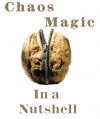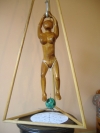As we enter the third millennium we find ourselves in an increasingly dynamic religious marketplace. Many traditional faiths have either retreated into fundamentalism or have undergone various reformations, whilst new faiths have attempted to establish themselves and ancient faiths have attracted numerous attempts at revivalism.
Rarely since the days of the late Roman Empire have so many faiths come into creative and destructive confrontation with each other, and rarely have we seen so much innovation in matters of faith and ideology and in religious and mystical practise.
This essay evolves from three main sources, firstly perhaps from late night undergraduate philosophical discussions some forty years ago when my companions and I joked about creating new religions for fun and profit. This occurred in a cultural milieu in which traditional religions had come under severe question and novel and imported cults abounded. Secondly it comes from my experiences in trying to develop better ways of thinking about and practising magic. Perhaps inevitably I became involved in initiatives to broaden the basic ideas of this new magic (Chaos Magic) into a more comprehensive world view that encompassed some of the traditional territory of religion. Thirdly it comes from my experience of numerous groups which have attempted to set up magical and mystical traditions, many of which have sprung from a similar cultural milieu as Chaos Magic.
Whether any of these traditions survives and prospers probably depends on how well they can satisfy the fairly broad demands that humans have when it comes to something to invest belief in.
The meme-sphere of humanities ideas and beliefs exhibits the usual power law distribution; we see many faiths with wildly varying numbers of followers involved. We have everything from a few major faiths with a billion or a few million adherents, to several million faiths with as few as a handful or just a single adherent each. Even beneath the umbrellas of the major faiths we observe major schisms and factionalisms between various doctrinal interpretations and forms of practise.
Epochs of social change and eras of interfaces between cultures always produces fresh thoughts, and as human culture globalises itself through enhanced communication and travel we witness a plethora of conceptions of faith and religious practices today, sometimes these interact in creative interface and sometimes they enter into deadly conflict with each other.
Nowadays we cannot discount the contemporary influence of the belief systems of various interpretations of science and secularism and the resultant humanisms (and in-humanisms) that have derived from it, for these have had a profound influence on metaphysics and morality since the Enlightenment.
I would guess that on top of all the advertised and census declared faith allegiances we probably have at least a billion humans who basically use some version of a semi-scientific paradigm as their basic modus operandi and worldview, but they have retained vestiges of old faiths or added bits and pieces from new or revived mystical ideas on top or underneath of that.
Perhaps it takes a dispassionate scientific observer to unravel the various strands of thought and practise in all these old and new faiths.
Writing in New Scientist Number 2805, the columnist Kate Douglas draws on the work of several commentators and poses the question ‘What form would the ideal religion take?’ This forms part of a larger article called Total Reboot. This ‘Total Reboot’ article speculates that many of the structures of our civilisation have not evolved to function as well as they might; and that if we tried to design them from scratch now we would probably try something else. In fact large numbers of people do seem engaged in trying to evolve designer religions by various pick and mix and trial and error methods these days, either to merely satisfy themselves or to attract more widespread interest in their conclusions.
So what ingredients do religions actually have, and what can they have, and what would constitute the ideal religion?
Kate Douglas identifies five major components, most of which occur to some extent in most religions.
1) ‘SACRED PARTY’. Roman Catholicism specialises in this with its vestments, decorations, rituals, bells and smells and sacraments and music and song, as do many oriental religions. Islam and the more puritan Protestant forms of Christianity often tend to downplay this aspect. Modern Witchcraft and Paganism often tend to play it up to the max, adding dance and other forms of celebration, with occasional reference to the purported orgiastic rites of ancient cultures, and to similar events alleged to have occurred in other historical anti-mainstream religious cults.
2) ‘THERAPY’. Most religions have prayers or meditations designed to have psychological effects and some go further with rituals of healing or the casting out of evil spirits or of sins and guilt and the invocation of more desirable states of mind. Many of the New-Age traditions place great emphasis on the psychotherapeutic virtues of meditation techniques and themes derived from esoteric and mystical traditions and often discard much of the traditional symbolism that once accompanied them.
3) ‘MYSTICAL QUEST’. Some forms of Buddhism place emphasis on enlightenment for all, but because intense mysticism often leads to schism, many religions reserve it for specialists only such as Monks and Nuns, Sufis, Kabbalists and Saddhus. Nevertheless some religions do use practices designed to create ecstatic experiences and revelation, but without theological discipline such practices can prove immiscible with the structure of the religion. The Thelemic faith places great emphasis on the discovery of true will, and like all tantalising quest objectives such as enlightenment it remains rather imprecisely defined. Christian salvation remains somewhat paradoxical as well as the better you get at it the higher they raise the bar, despite that it seems a sort of all or nothing event.
4) ‘SCHOOL’. The study or even the mere rote learning and recitation of scripture, myth, and lore feature in all religions and in most religious ceremonies. Judaism and Islam specialise in this, although in Catholicism the laity receive no encouragement to study scripture. Scholastic reinforcement of belief and practise becomes particularly problematical for new, revisionist, or revived religions, where alternative ideas may lack solid historical justification and require an act of selective attention and faith to have an effect. Christianity rather cheekily simply bolted on the old Judaic scriptures to create a larger cannon of study for itself.
5) ‘MAGIC’. All religions contain some ideas or doctrines that seem to transcend the principles of science or the everyday expectations of common sense. Miracles or at least strangely improbable events seem to characterise the founding myths of most religions. Most religions reserve the right to pray or hope for extraordinary intercession. Contra-reasonable beliefs characterise all religions and magical-mystical enterprises. Sometimes these depend on the supposed powers of various deities; sometimes they supposedly depend on the quality of the faith of their adherents or on some innate and barely recognised powers, such as Baraka, Chi, Holiness, Kia, or latterly, Quantum Coherence.
Either way, religions often provide the hope and the motivation to achieve what seems impossible by normal means, sometimes it works, sometimes it doesn’t. We still lack comprehensive theories of our own Psychological and Para-psychological abilities and limits.
The human enterprise goes on, we stumble into the darkness, lighting fires where we can, perhaps hoping for life after death, physical immortality, reincarnation, virgin birth, miracles, or just low level wish fulfilment, and answered prayers.
Personally I would add several other features to Kate’s list:
6) ‘OTHERNESS’. As the anthropologist Bronislaw Malinkowski observed, ‘Ritual Language has a High Coefficient of Weirdness’, it usually resumes archaic or mysterious forms, as does the entire process of religious practise. Such practices usually stand outside of everyday behaviour and employ strange clothing, unusual architecture, and peculiar postures and movements as well, to denote their special-ness, sacredness, and their separation from ordinary life. The Catholic abandonment of Latin Mass does seem a mistake in this respect, the Protestant retention of archaic Old Testament language from the King James Bible looks like an attempt to capitalise on this effect. Religion needs its own idiosyncratic poetry.
7) ‘SACRIFICE’. Kate Douglas touches on this briefly when mentioning groups which demand bodily mutilation or which have traumatic initiation rites, observing that if members have to pay a high entry price they tend to become more committed. However there seems more to it than that. All religions seem to embody some sort of notion of exchange or sacrifice. Simple ideas of making material offerings and blood sacrifices to make bargains with deities, or at least to attract their favour, tend to give way to more sophisticated concepts of self-denial or investment of effort to achieve similar metaphysical effects and to deepen the sense of investment in, and commitment to the religion. Virtually all religions have rules about earthy behaviour, usually concerning various taboos about what you should or should not eat, and with whom you should and should not have sexual activity. Thus they enforce certain concepts of sacrificing some natural desires or pleasures for metaphysical gain or to reinforce social identity.
8) ‘WORLDLY QUEST’. Most religions have some kind of agenda in the world as well as some form of mystical quest. Usually such worldly quests have extremely challenging if not impossible objectives such as world conquest in the name of the faith, or world peace, or global enlightenment, or the establishment of the kingdom of heaven or ecological paradise on earth. Thus the majority of religions exhibit some tendency to proselytise with varying degrees of enthusiasm or aggression.
Now perhaps we can see why raw Scientism has failed to completely capture the imagination of modern humans, and why all attempts to create entirely rational or ’sensible’ religions have failed. Perhaps we can also see why so many novel cults and religions rarely manage to ensure their own survival if they fail to broaden the base of their appeal.
They simply do not tick enough of the above 8 boxes.


